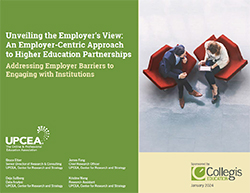In our recent blog series, we’ve discussed how to review your school’s academic portfolio and evaluate individual programs. Colleges and universities must continually consider their mix of programs and carefully select new programs to remain relevant to the needs of students, employers, and society.
Institutions increase the likelihood that new programs will thrive by considering complex data sets, including market demand, competition, and financial projections. This data-driven decision making provides the basis for realistic expectations on investments and returns.
Let’s look at recommended data sources.
Identifying workforce needs through market analysis
An analysis of the demand for specific degrees, skills, or disciplines can identify emerging trends, regional workforce needs, and areas of anticipated job growth in the region, which provides a solid foundation for identifying potential program offerings.
By examining a combination of labor market trends, employment projections, and occupational outlooks, colleges and universities can gain valuable insights into areas of growth and demand for skilled professionals.
Data sources may include the following:
- Government agencies, such as the Bureau of Labor Statistics (BLS)
- Job posting and recruitment platforms, which aggregate data on job postings and offer real-time information about the skills and qualifications employers are seeking
- Labor market analytics tools that use big data and machine-learning algorithms to analyze job market trends, skills demand, and salary data
Understanding student needs and aligning programs with demand
Understanding student needs and preferences is essential for designing programs that resonate with the target audience. Assess student needs by:
- Analyzing enrollment data and trends within existing programs
- Gathering data from your enrollment management team about what prospective students are looking for
- Reviewing Google search trends for insights into student demand outside of the institution
- Analyzing enrollment and completion data from regional competitors
Differentiating your offerings through competitive program analysis
Understanding the competitive landscape is equally important. Identifying programs offered by your competitors — their structure, cost, and delivery — and then comparing that data to your market analysis will provide insights into what competitors are offering and highlight areas of opportunity for differentiating your programs.
By aligning new offerings with student aspirations and career goals, universities can attract and retain a diverse and engaged student body. This can further inform decisions about where to invest resources for new program development.
Securing program sustainability: Financial viability and resource allocation
Financial considerations should play a substantial role in the analysis of new program opportunities. A thorough financial analysis should assess the potential costs, revenue streams, and return on investment associated with launching and sustaining new programs.
Identify resource requirements, including faculty, staff, facilities, technology, marketing, recruitment, retention, and administrative support, to ensure the institution can adequately support the proposed programs.
The uncertainty in the shifting higher education market should be built into financial forecasting. Additionally, flexibility to adjust based on actual performance is necessary. Institutions are well advised to develop a multi-year pro forma that establishes realistic revenues, costs, and ROI timelines based on market conditions.
Leveraging institutional strengths and brand for program development
New academic programs should align closely with the mission, values, and strategic priorities of the institution. Institutions should leverage their existing academic strengths, faculty expertise, resources, and brand when considering new programs.
By building on established areas of excellence and reputation, colleges and universities can create innovative and competitive programs that set them apart in the higher education landscape. New offerings must complement and enhance the academic portfolio of the institution and build on the institutional reputation.
Industry partnerships and engagement
Leveraging relationships with employers and industry associations in the region will provide important insights into workforce needs. Additionally, advisory boards composed of employers who can provide firsthand perspective on workforce realities are a valuable source of insight for developing in-demand programs.
Major employers and associations can provide information about program naming, program outcomes, curricula, marketing channels, and degree levels (associate, bachelors, masters, certificate). These relationships also help you reach your intendent audience and build pathways for internships, hiring opportunities, and program instructor resources.
Continuous program evaluation and adaptation
To maintain a healthy portfolio of programs, the selection of new academic programs must be accompanied by timely and continuous program evaluation and adaptation. Regular monitoring of performance based on agreed-upon metrics will provide decision makers with the information necessary to make data-driven decisions.
Those metrics should include enrollment trends, student outcomes, alumni success, employer feedback, financial performance, and other relevant measures of program success. Flexibility and agility are essential for responding to evolving market demands, technological advancements, and changes in student needs.
Crafting the future
Innovative and sustainable programs that support the institutional mission are essential to a healthy, balanced portfolio. Selecting new academic programs requires a combination of strategy, discipline, and process informed by multiple relevant and current data sources. With careful planning and execution, universities can navigate the path to success and ensure their academic programs remain relevant, impactful, and sustainable in the years to come.
Adopting this culture of continual review and reflection can be challenging. Collegis can provide an objective assessment of your new program opportunities and give you the tools you need to future-proof your academic portfolio. Contact us to get started.
Author: Tracy Chapman, PhD
Tracy Chapman, PhD., serves as Collegis’s Chief Academic Officer. Chapman’s 20+ years in academia includes leadership, scholarship, and innovative approaches to reaching students. Prior to joining Collegis, Chapman served as the dean of the School for Professional Studies and associate provost for Distance Education at Saint Louis University, and led Creighton University’s Center for Academic Innovation.





